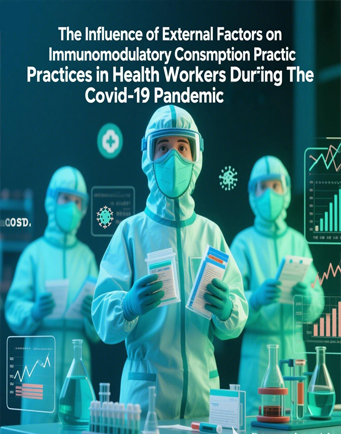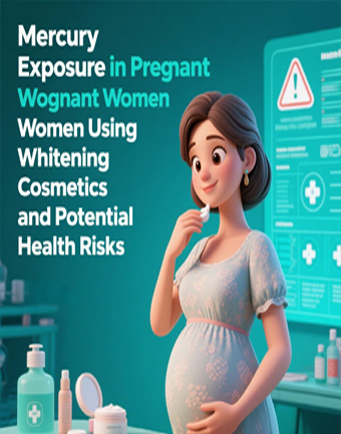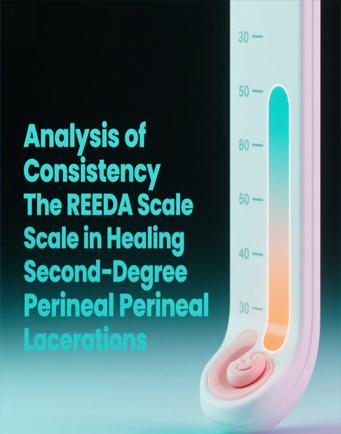Comparison of Lipid Profiles among Vegan Vegetarians, Lacto-Ovo Vegetarians and Non-Vegetarians

Downloads
The lipid profile is a crucial indicator of cardiovascular disease risk, with elevated levels often influenced by dietary patterns. Nutrient intake and physical activity can help regulate cholesterol by reducing total cholesterol, HDL, LDL and triglyceride levels. This study aims to compare the lipid profiles among vegan vegetarians, lacto-ovo vegetarians, and non-vegetarians. This research uses a cross-sectional study design. The study population includes 60 participants from IVS and the Yogyakarta community, selected based on inclusion and exclusion criteria. The research examines diet type as the independent variable, lipid profile as the dependent variable, and physical activity as a confounding variable. Data collection involves respondent identity and a physical activity questionnaire using IPAQ. Statistical analyses include one-way ANOVA, Post Hoc tests and multivariate analysis with one-way MANCOVA. The research results show that the total cholesterol level for vegan (173.10±21.04), lacto-ovo (169.45±44.84), and non-vegetarians (194.55±31.40). HDL levels for vegan are (55.25±10.79), lacto-ovo (49.00±9.12), and non-vegetarians (45.49±9.11). LDL levels for vegan are (111.90±19.80), lacto-ovo (114.85±44.39), and non-vegetarians (134.90±30.37), showing no significant difference p>0.05. Triglyceride levels for vegan are (103.15±57.06), lacto-ovo (100.65±60.07), and non-vegetarians (154.15±88.63) with significant differences p-value <0.05. When controlling for physical activity, differences in total cholesterol, HDL, and triglycerides persist between diet groups. Notably, HDL levels differ significantly between vegans and lacto-ovo (p<0.05). The conclusion is that both vegan and lacto-ovo diets have lipid profiles within the normal range compared to non-vegetarian diets. A vegetarian diet and regular physical activity contribute to a healthier lipid profile.
Antoniazzi, L., Acosta-Navarro, J., Oki, A. M., Bonfim, M. C., & Gaspar, M. C. A. (2022). Better Adequacy of Food Intake According to Dietary Recommendations of National Cholesterol Education Program in Vegetarian Compared to Omnivorous Men. International Journal of Cardiovascular Sciences, 35(1), 1–10. https://doi.org/10.36660/ijcs.20200258
Bondge, B., Jain, J., Warkad, M., Joshi, M., More, S., & Janaarthanan, S. (2021). Association of physical activity with lipid profile in healthy subjects: A cross sectional study in tertiary care hospital from central rural India. Indian Journal of Endocrinology and Metabolism, 25(6), 520–526. https://doi.org/10.4103/ijem.ijem_327_21
Chang, S. L., Lee, K. J., Nfor, O. N., Chen, P. H., Lu, W. Y., Ho, C. C., … Liaw, Y. P. (2020). Vegetarian diets along with regular exercise: Impact on high-density lipoprotein cholesterol levels among taiwanese adults. Medicina (Lithuania), 56(2), 1–9. https://doi.org/10.3390/medicina56020074
Chang, S. L., Nfor, O. N., Ho, C. C., Lee, K. J., Lu, W. Y., Lung, C. C., … Liaw, Y. P. (2020). Combination of exercise and vegetarian diet: Relationship with high density-lipoprotein cholesterol in taiwanese adults based on MTHFR rs1801133 polymorphism. Nutrients, 12(6), 1–10. https://doi.org/10.3390/nu12061564
Dawczynski, C., Weidauer, T., Richert, C., Schlattmann, P., Dawczynski, K., & Kiehntopf, M. (2022). Nutrient Intake and Nutrition Status in Vegetarians and Vegans in Comparison to Omnivores - the Nutritional Evaluation (NuEva) Study. Frontiers in Nutrition, 9(May), 1–18. https://doi.org/10.3389/fnut.2022.819106
Dybvik, J. S., Svendsen, M., & Aune, D. (2023). Vegetarian and vegan diets and the risk of cardiovascular disease, ischemic heart disease and stroke: a systematic review and meta-analysis of prospective cohort studies. European Journal of Nutrition, 62(1), 51–69. https://doi.org/10.1007/s00394-022-02942-8
Fontes, T., Lopes, S., Menezes, R., Esgalhado, M., Monteiro Rodrigues, L., & Ferreira-Pêgo, C. (2024). Exploring Vegetarian and Omnivorous Approaches to Cardiovascular Risk and Body Composition. Nutrients, 16(13). https://doi.org/10.3390/nu16132013
Gogga, P., Śliwińska, A., Aleksandrowicz-Wrona, E., & Małgorzewicz, S. (2021). Lipid profile in Polish women following lacto-ovo-vegetarian and vegan diets – preliminary study. Acta Biochimica Polonica, 68(4), 751–755. https://doi.org/10.18388/abp.2020_5653
Jedut, P., Glibowski, P., & Skrzypek, M. (2023). Comparison of the Health Status of Vegetarians and Omnivores Based on Biochemical Blood Tests, Body Composition Analysis and Quality of Nutrition. Nutrients, 15(13). https://doi.org/10.3390/nu15133038
Jo, U., & Park, K. (2023). Carbohydrate Intake and Risk of Cardiovascular Disease: A Systematic Review and Meta-Analysis of Prospective Studies. Nutrients, 15(7). https://doi.org/10.3390/nu15071740
Kemala, A. A. I. S., Wihandari, D. M., & Wiryanthini, I. A. D. (2021). Hubungan Asupan Zat Gizi dengan Profil Lipid pada Diet Vegetarian di Kota Denpasar. Jurnal Medika Udayana, 10(4). https://doi.org/10.24843.MU.2021.V10.i7.P11
Khoerunisa, D., & Istianah, I. (2021). Hubungan Asupan Zat Gizi Makro Dan Aktivitas Fisik Dengan Status Gizi Pada Remaja. Jurnal Pangan Kesehatan Dan Gizi Universitas Binawan, 2(1), 51–61. https://doi.org/10.54771/jakagi.v2i1.236
Kwiatkowska, I., Olszak, J., Formanowicz, P., & Formanowicz, D. (2023). Dietary Habits and Lifestyle, Including Cardiovascular Risk among Vegetarians and Omnivores during the COVID-19 Pandemic in the Polish Population. Nutrients, 15(2). https://doi.org/10.3390/nu15020442
Lee, Y. J., Park, Y. H., Lee, J. W., Sung, E. S., Lee, H. S., & Park, J. (2022). Household-specific physical activity levels and energy intakes according to the presence of metabolic syndrome in Korean young adults: Korean National Health and nutrition examination survey 2016–2018. BMC Public Health, 22(1), 1–12. https://doi.org/10.1186/s12889-022-12852-3
Lombardo, M., Feraco, A., Camajani, E., Gorini, S., Strollo, R., Armani, A., … Caprio, M. (2024). Effects of Different Nutritional Patterns and Physical Activity on Body Composition: A Gender and Age Group Comparative Study. Foods, 13(4). https://doi.org/10.3390/foods13040529
Matsumoto, S., Beeson, W. L., Shavlik, D. J., Siapco, G., Jaceldo-Siegl, K., Fraser, G., & Knutsen, S. F. (2019). Association between vegetarian diets and cardiovascular risk factors in non-Hispanic white participants of the Adventist Health Study-2. Journal of Nutritional Science, 8. https://doi.org/10.1017/jns.2019.1
Mentari, R., Anandito, R. B. K., & Basito. (2016). Formulasi daging analog berbentuk bakso berbahan kacang merah (Phaseolus vulgaris L.) dan kacang kedelai (Glycine max). Jurnal Teknosains Pangan, 5(3), 31–41. Retrieved from: https://jurnal.uns.ac.id/teknosains-pangan/article/viewFile/7244/6424
Müller, M., Canfora, E. E., & Blaak, E. E. (2018). Gastrointestinal transit time, glucose homeostasis and metabolic health: Modulation by dietary fibers. Nutrients, 10(3). https://doi.org/10.3390/nu10030275
Nudhar, L., Subandrate, S., Susilawati, S., & Oswari, L. (2020). Mean Differences of Total Cholesterol Levels among Vegetarians and Nonvegetarians at Maha Vihara Maitreya Duta Palembang. Fol Med Indones, 56(3), 197–202. https://doi.org/10.20473/fmi.v56i3.24555
Perkeni. (2021). Panduan Pengelolaan Dislipidemia di Indonesia. Jakarta: PB PERKENI.
Pimentel, C. V. D. M. B., Philippi, S. T., Simomura, V. L., & Teodorov, E. (2019). Nutritional status, lifestyle and lipid profile in vegetarians. International Journal of Cardiovascular Sciences, 32, 623-634. https://doi.org/10.5935/2359-4802.20190044
Pritasari, P., Damayanti, D., & Tri, N. (2017). Gizi dalam Daur Kehidupan. Jakarta: Kementerian Kesehatan Republik Indonesia.
Probandari, A. N., Pamungkasari, E. P., Febrinasari, R. P., Sumardiyono., & Widyaningsih, V. (2020). Metode Penelitian Kuantitatif. Surakarta: UNS Press.
Qi, L., Ding, X., Tang, W., Li, Q., Mao, D., & Wang, Y. (2015). Prevalence and risk factors associated with dyslipidemia in Chongqing, China. International Journal of Environmental Research and Public Health, 12(10), 13455–13465. https://doi.org/10.3390/ijerph121013455
Ramadhani, F., Hatta, H., Nuryani, N., Maesarah, M., Adam, D., Sillehu, S., & Nugroho, H. S. W. (2022). Correlation of Energy, Protein, Carbohydrate, and Physical Activity Intake with Nutritional Status of Adolescents. Open Access Macedonian Journal of Medical Sciences, 10(E), 1440–1445. https://doi.org/10.3889/oamjms.2022.8110
Richter, M., Boeing, H., Grünewald-Funk, D., Heseker, H., Kroke, A., Leschik-Bonnet, E., … Watzl, B. (2016). Vegan Diet. Position of the German Nutrition Society (DGE). Ernaehrungs Umschau International, 63(04), 92-102. Erratum in: 63(05): M262. https://doi.org/10.4455/eu.2016.021
Saintila, J., Lozano López, T. E., Calizaya-Milla, Y. E., White, M., & Huancahuire-Vega, S. (2021). Nutritional knowledge, anthropometric profile, total cholesterol, and motivations among Peruvian vegetarians and non-vegetarians. Nutricion Clinica y Dietetica Hospitalaria, 41(1), 91–98. https://doi.org/10.12873/411saintila
Segovia-Siapco, G., Burkholder-Cooley, N., Haddad Tabrizi, S., & Sabaté, J. (2019). Beyond meat: A comparison of the dietary intakes of vegetarian and non-vegetarian adolescents. Frontiers in Nutrition, 6(June), 1–11. https://doi.org/10.3389/fnut.2019.00086
Storz, M. A., Müller, A., Niederreiter, L., Zimmermann-Klemd, A. M., Suarez-Alvarez, M., Kowarschik, S., … Hannibal, L. (2023). A cross-sectional study of nutritional status in healthy, young, physically-active German omnivores, vegetarians and vegans reveals adequate vitamin B12 status in supplemented vegans. Annals of Medicine, 55(2). https://doi.org/10.1080/07853890.2023.2269969
Sukmawati, A., Sitoayu, L., Wahyuni, Y., & Putri, V. H. (2021). Perbedaan Asupan Energi, Zat Gizi Makro dan Serat Berdasarkan Kadar Kolesterol Total pada Dewasa Muda Vegetarian di Indonesia Vegetarian Society Jakarta. Jurnal Kesehatan Masyarakat Indonesia, 16(1), 60. https://doi.org/10.26714/jkmi.16.1.2021.60-72
Syarfaini, Ibrahim, I. A., & Yuliana. (2020). Hubungan Pola Makan dan Aktivitas Fisik terhadap Kadar Kolestrol pada Aparatur Sipil Negara. Jurnal Kesehatan, 13(1), 53–60. https://doi.org/10.24252/kesehatan.v13i1.14156
Utama, W. F., Herawati, S., & Wande, I. N. (2021). Gambaran Rasio Profil Lipid pada Pasien Penyakit Jantung Koroner di RSUP Sanglah Periode Januari-Juni 2018. Jurnal Medika Udayana, 10(4). https://doi.org/10.24843.MU.2021.V10.i4.P04
Wang, L., Li, Y., Liu, Y., Zhang, H., Qiao, T., Chu, L., … Dai, J. (2023). Association between Different Types of Plant-Based Diets and Dyslipidemia in Middle-Aged and Elderly Chinese Participants. Nutrients, 15(1), 1–16. https://doi.org/10.3390/nu15010230
Widiastuti, I. A. E., Priyambodo, S., & Cholidah, R. (2023). Differences In Lipid Profiles Based on Physical Activity Levels Among First-Year Students In a Medical Education Research Program. Jurnal Penelitian Pendidikan IPA, 9(2), 981–985. https://doi.org/10.29303/jppipa.v9i2.3627
Zaki, M. Al, Umar, U., Yenes, R., Rasyid, W., Ockta, Y., & Budiwanto, A. (2023). The Impact of Regular Physical Activity on Lipid Profile and Cardiovaskular Health in Adolescents : A Literature Review. Jurnal Penelitian Pendidikan IPA, 9(SpecialIssue), 213–221. https://doi.org/10.29303/jppipa.v9ispecialissue.7811
Copyright (c) 2024 JURNAL INFO KESEHATAN

This work is licensed under a Creative Commons Attribution-NonCommercial-ShareAlike 4.0 International License.
Copyright notice
Ownership of copyright
The copyright in this website and the material on this website (including without limitation the text, computer code, artwork, photographs, images, music, audio material, video material and audio-visual material on this website) is owned by JURNAL INFO KESEHATAN and its licensors.
Copyright license
JURNAL INFO KESEHATAN grants to you a worldwide non-exclusive royalty-free revocable license to:
- view this website and the material on this website on a computer or mobile device via a web browser;
- copy and store this website and the material on this website in your web browser cache memory; and
- print pages from this website for your use.
- All articles published by JURNAL INFO KESEHATAN are licensed under the Creative Commons Attribution 4.0 International License. This permits anyone to copy, redistribute, remix, transmit and adapt the work provided the original work and source is appropriately cited.
JURNAL INFO KESEHATAN does not grant you any other rights in relation to this website or the material on this website. In other words, all other rights are reserved.
For the avoidance of doubt, you must not adapt, edit, change, transform, publish, republish, distribute, redistribute, broadcast, rebroadcast or show or play in public this website or the material on this website (in any form or media) without appropriately and conspicuously citing the original work and source or JURNAL INFO KESEHATAN prior written permission.
Permissions
You may request permission to use the copyright materials on this website by writing to jurnalinfokesehatan@gmail.com.
Enforcement of copyright
JURNAL INFO KESEHATAN takes the protection of its copyright very seriously.
If JURNAL INFO KESEHATAN discovers that you have used its copyright materials in contravention of the license above, JURNAL INFO KESEHATAN may bring legal proceedings against you seeking monetary damages and an injunction to stop you using those materials. You could also be ordered to pay legal costs.
If you become aware of any use of JURNAL INFO KESEHATAN copyright materials that contravenes or may contravene the license above, please report this by email to jurnalinfokesehatan@gmail.com
Infringing material
If you become aware of any material on the website that you believe infringes your or any other person's copyright, please report this by email to jurnalinfokesehatan@gmail.com.





































